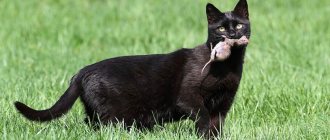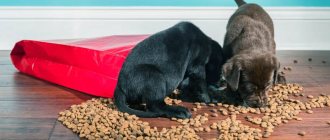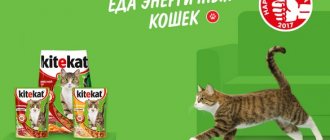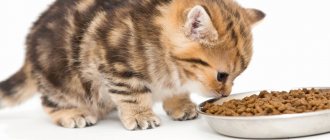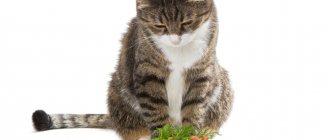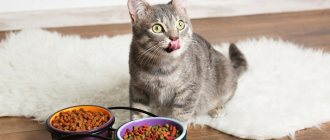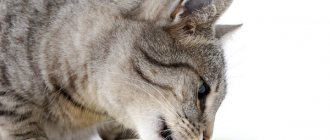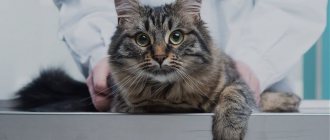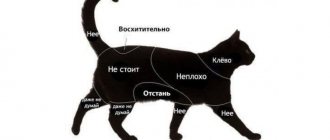If a cat has health problems or age-related changes have occurred, it should be switched to another food. Therefore, the owner must know the general rules for transferring to a new diet and act in stages. It is also necessary to take into account the time required for a successful transition. This also applies to those owners who want to switch their pet from industrial food to natural food.
According to veterinarians, a rapid transition to another food is allowed only in the case of an aggressive form of an allergic reaction or when diseases of the internal organs are detected, when a special diet is required; in other circumstances, the transition should be gradual.
The animal has grown old
Like all living organisms on this planet, cats age and there is a risk of developing various diseases, including obesity. To avoid this, you need to choose a diet with a lower calorie content. It is better not to use food with a high protein content for an aging animal. But for very old cats, the opposite is true; due to poor absorption of food, the animal may develop vitamin deficiency, so you need to add more vitamins to the diet; protein is also necessary for such a cat.
How long will it take to change food?
Ideally, owners who are patient enough have up to ten days to gradually change the cat’s usual food to a new one. In order to injure the animal as little as possible, the transfer is carried out gradually. Initially, in the first days, about 25% of new food is added to the animal’s diet. When, after eating several times, the cat becomes accustomed to the innovation, the amount of new food is increased to 50%. After a week of changing the diet, the new food may well account for three-quarters of the total amount of food.
Thus, day by day increasing the amount of new food, we ensure that the animal switches from its usual food to a new one. However, unfortunately, for many owners of particularly capricious animals, everything does not go so smoothly. What to do in this case?
Basic rules for switching a cat to another food
You can, of course, immediately give the animal new food, in 90% of cases the cat will simply refuse the new food, and this can also lead to an upset stomach and vomiting. So how can you correctly switch a cat to another food so as not to injure the animal or cause damage to the pet’s gastrointestinal tract? To prevent the animal from noticing a sudden change in diet, you need to add new food to the cat’s usual food in small portions for 10 days. This way you can check if your cat is allergic to a new food. If the animal has responded well to the new food and eats it with pleasure along with the old one, then you can gradually, by adding new food in small portions, remove the old food from the diet. On average, such a transfer is completed in 3-4 weeks. If the cat tolerates the new product well, the transfer time can be reduced to 2 weeks.
If for some reason your pet refuses new food, leaving it in the bowl, there is another way to switch your cat to another food, but it may seem very inhumane, although it is very effective. The essence of the method is to temporarily put the cat on a starvation diet. Having refused a portion of new food, the cat expects that he will now be fed his usual food, but nothing happens. After walking around looking unhappy, the hungry cat again approaches the bowl. After several such approaches, the cat eats the remains of the new food. The next day, we again dilute the favorite food with new food and do not give anything else until the bowl is empty. This diet is acceptable for 3-4 days. But if the pet continues to refuse new food, you should contact your veterinarian and ask how to switch the cat from one food to another, otherwise the animal may begin to develop a dangerous liver disease, which is fatal.
When switching an animal from natural food to dry food, or vice versa, you can give the cat prebiotics. They will help the gastrointestinal tract adapt to new food faster.
There are times when a sudden change is necessary, for example, when switching an animal to medicinal food, when an intolerance to components of the usual menu appears, or when there is a food allergy. In this case, there is a little trick on how to switch a cat to another dry food, which is to lightly pour fish broth over the dry food. This will attract the animal's attention. Do not forget to constantly monitor the condition of your pet, its behavior, appearance, so that there are no negative reactions. If any symptoms appear, contact your veterinarian immediately. A timely visit to a specialist will help preserve the life and health of your pet.
Patience comes first
The first thing you need to do is be patient. All members of the cat family have an innate cunning that they will certainly use to sabotage your plans for replacing food. First of all, you will find a trick with “burying”, which clearly compares the new diet with litter for the tray.
Let’s not forget the pained expression on his face, sad glances and heart-rending meows - your pet will do everything to evoke pity and create the impression of a creature dying of hunger. But you can’t give in to provocations! Reluctantly, we stand our ground!
Here we will immediately make a reservation that all owners love their cats. But love is not only about pampering and caresses, but also about the need to sometimes make difficult decisions and take responsibility. What food to switch your cat to and when is just such a case.
Tips for feeding cats
Experienced veterinarians identify several basic rules when feeding cats:
- There is no need to mix dry food and canned food in one feeding.
- 2If the animal is fed on feed, it must be premium. Feeding an animal with expensive food is many times cheaper than spending money on treatment after using cheap analogues.
- There is no need to get carried away with wet food - if used frequently, they provoke obesity. They go as a dessert, sometimes you can pamper your beloved pet, but nothing more.
- Dry food lovers should always have a bowl of clean drinking water. Wet food consists of 70% water, but dry food contains much less water. In order for the animal to receive adequate nutrition from dry food, it needs to drink a lot. If a cat doesn't drink enough water, it will affect its well-being. If the condition worsens, you should urgently show the animal to a veterinarian.
- Without compelling reasons, there is no need to change feed frequently, and if this is a necessary measure, then follow the rules outlined above.
- Do not feed food strictly according to the norms indicated on the box. The cat will eat as much as she needs, she will leave the excess in the bowl, but starvation leads to a number of diseases.
- If you feed your cat natural products, then do not forget to add vitamins and minerals to the diet.
A veterinarian will help you perfectly balance your animal’s diet.
Transfer to natural food
Cats are carnivores by nature, so they need meat.
We feed our pets dry food solely out of laziness. By arranging a comfortable existence for ourselves, we cause irreparable harm to the pet, crippling not only its physical, but sometimes also its mental health.
For this reason, switching a pet to a diet that is normal for a living creature is a whole problem that not every owner can cope with.
Switching to a natural diet is not so easy. Felines are predators and carnivores; soups and porridges are not suitable for them. You need to prepare for the fact that you will have to monitor the balance of nutrition, the freshness of products, their variety, and prepare separately only for a cat.
Cat bowl with budget dry food
No dry food - a radical method
There are 4 main stages of transition:
Preparation - natural and dry food are mixed, with a minimum amount of granules. This nutrition system lasts for 2-3 days. Adding biological additives
To stimulate the gastrointestinal tract, vitamins are added to food to stimulate the digestive system. Cleaning up dry food - you can’t hide it, it’s important to completely remove the food from the house so that the cat doesn’t smell or hear the familiar rustling sound. Donate food to pet-loving neighbors or feed homeless animals. No concessions - the cat may refuse to eat for several days, but he will not be able to starve himself and will begin to eat unusual food
You should not succumb to your pet’s “provocations,” as he will quickly understand how he can get his usual food.
The period of adaptation is 3-14 days.
What are artificial feeds?
There is also plenty written and said about artificial food for cats today. But basically this is a discussion about which food is better: premium or economy class? What is cheaper and what do cats eat better? The question of whether a cat needs to be fed artificial food at all is rarely raised.
Mostly canned food and dry food for cats are bought because we are lazy. Yes, yes, let's call a spade a spade. First of all, we take care of ourselves. When purchasing artificial food, we don’t bother ourselves with the question “what to give the cat for dinner.” I bought canned food, opened it, poured it into a bowl - and that’s it. Minimum expenditure of thought processes and time.
Natural food is healthier than artificial food.
Advertising of food also greatly contributed to their popularity and somewhat distorted our understanding of a cat’s diet. It is thanks to advertising that we know for certain that cats simply “need” cereals and other silage. But let me remind you that a cat is a carnivorous predator, which by definition cannot become a vegetarian.
In order to understand what ready-made food should consist of, you can remember what the menu of a cat in the village consists of (as close as possible to natural conditions). These are mainly small rodents, less often birds, and even less often fish and insects (moths and grasshoppers). All this is divided into:
- meat - animal proteins;
- bones and skin - calcium and phosphorus.
All that is contained in the victim's stomach is plant fibers and grains. Separately, cats eat grass occasionally for reasons of maintaining their health.
Cats do not eat fermented milk products on their own. Only as kittens in their cat childhood, and if a person allows it. Raw milk in the stomach of an adult cat almost immediately curdles and is not digested.
What follows from all of the above? The fact is that ideally the food should contain all these ingredients in natural proportions. Namely:
- meat – 45%;
- animal protein (egg or milk) – 20%;
- entrails, bones, offal – 10%;
- vegetable components (vegetables, cereals) – 20%;
- the rest is natural mineral supplements and vitamins – another 5%.
But, unfortunately, there are no ideal feeds. They would be too expensive and unprofitable to produce.
So what are we (or rather cats) offered as cheaper food to produce? In order not to be unfounded, we simply read what is written in small letters on a can or bag of food:
- chemical preservatives, sugar substitutes and antioxidants (you can’t live without them);
- by-products (good in principle, but who can guarantee that blood or feather meal, tails, sinews and other waste from slaughterhouses do not go there);
- dyes, flavor enhancers;
- fillers (cellulose, soy, starch).
If the presence of chemical components is at the very least reflected on labels, then with by-products and fillers it is somewhat more complicated. The legislation of many countries does not say at all that the manufacturing company is obliged to indicate a complete list of what is included in the by-products. And no one knows what may be hidden under this formulation.
Cats eat all of the budget line food with by-products of “plant and animal origin” with great appetite due to the presence of generously sprinkled flavoring additives. It’s hardly worth talking about their usefulness. Quite the contrary.
Cats get hooked on artificial food and then not only do they not eat anything other than dry food, but they also often have health problems:
- then the metabolism is disturbed, and cats become fat before our eyes;
- then tumors develop out of the blue;
- or even some British Vicomte de Bragelonne suddenly dies from liver or kidney failure due to many years of excessive consumption of food.
